
A lot of golfers can lower their scores through effective putting practice quickly. In many ways, it's the easiest part of the game to improve because it does not require elite athletic ability and can be practiced almost anywhere. To help with this, here are five putting drills. Additionally, I’ve included a couple of games to take to the practice green, either to add something extra to your practice routine or to play with your golf buddies before or after you play.
Check Your Eye Alignment with Cups and a String
When aiming your putt, your vision should be looking straight down the target line. The problem is that for many golfers, this doesn’t mean having your eyes directly over the ball, as factors like eye dominance can influence our perception of alignment. The simple drill in this video from top putting instructor Phil Kenyon will show you how to use some everyday materials to discover your aligned setup position.
As seen in the video, you can use the string tied to two cups to set a straight line between a ball and the target, using the masking tape to create a reference for a square putter face. Placing a ball directly under the string between you and the target makes an alignment point for your eyes as the two balls should appear correctly in line. If the second ball seems to the left or right, you can adjust your eyes over the putt until you discover the position that matches your perception of alignment with reality.
Practice Consistency with the Gate Drill
Consistently returning the putter to the same position from address to impact is key to making short putts. Made famous by Tiger Woods, this drill is seen on practice greens from the pro tour to your local muni because it helps you do just that.
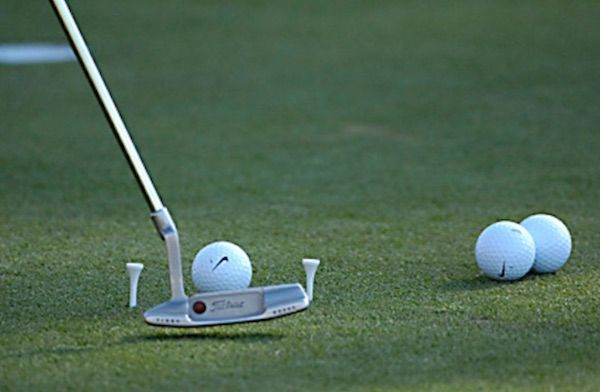
To start, place tees into the green at either side of your putter head with just enough room for the putter to pass through. Set up your practice putts with the putter inside the “gate,” then focus the stroke on making solid contact with the ball without hitting the tees. For an added layer of feedback, find a flat putting surface, and create an additional set of gates a putter length from the first. For the ball to pass through the middle of these gates, you’ll need to have maintained a square face at impact.
With this drill's success, it’s no surprise that several putting aids have been developed to take this drill to the next level. Putting mirrors have been a staple on the PGA Tour for years now. There are plenty of them out there, but this one from Eyeline golf is highly rated and will also help with your posture and setup.
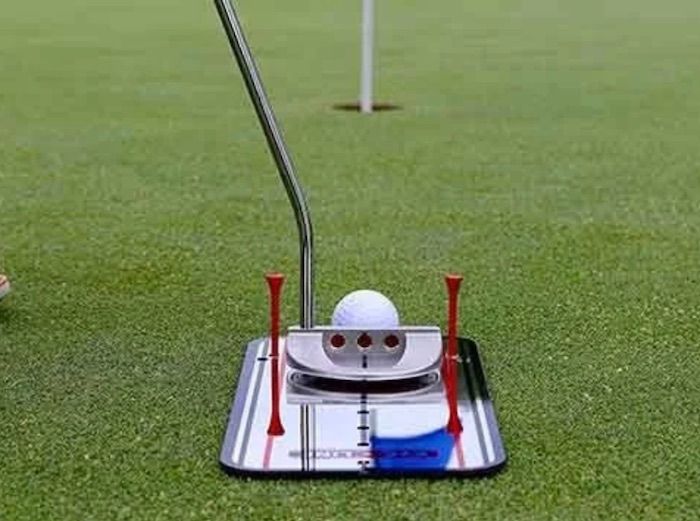
Also, the PuttOut Mirror is an excellent tool that combines gates and a mirror for feedback (check out our review here).
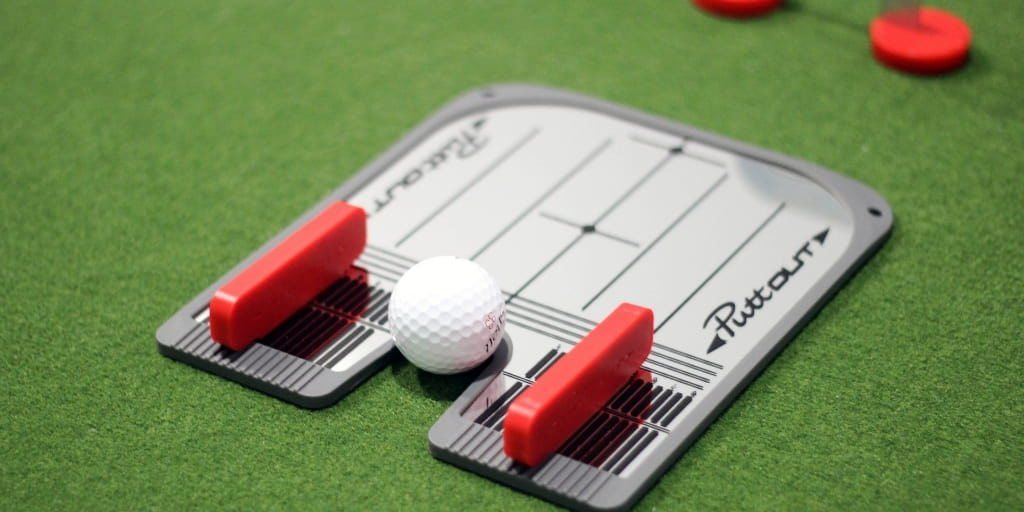
Hit the Sweet Spot with the Rubber Band Drill
Just like any other club in the bag, your putter has a sweet spot in the middle of the clubface that will produce the best results. For this drill, place rubber bands around your putter head, spaced wide enough apart to allow solid contact with the ball in the center of the face, but narrow enough to let you know if you were a bit off. It will likely take two or three wraps around the putter for the band to hold tight, forming the rails needed for the drill.
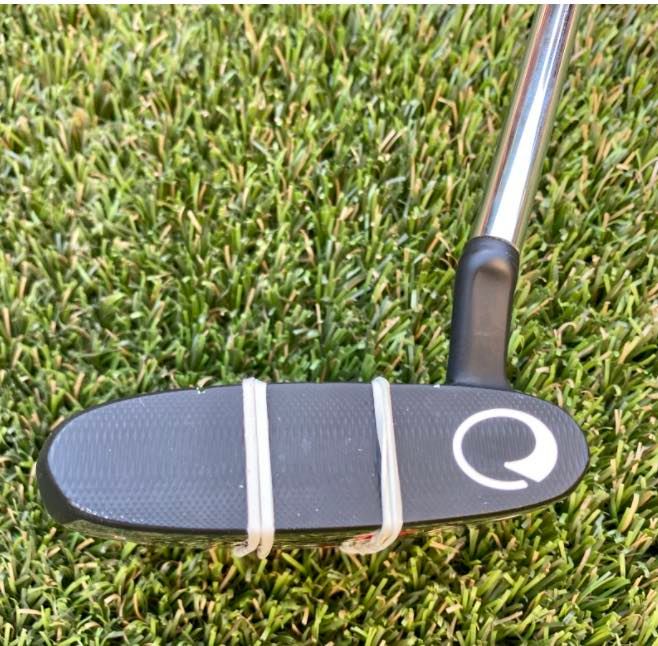
Once the bands are wrapped around the face, find a straight, level putt about two putter lengths from the hole and start striking putts, trying to make them. If you don’t strike the ball with the center of the clubface, you’ll feel the impact on the rubber, and the putt will be sent far offline. Putts struck with enough pace in the sweet spot should wind up in the hole on a flat surface, but if you’re hitting the center and the ball is still heading right or left, then you can add in other putting aids to check your alignment and to practice keeping the face square at impact.
Some putter heads, such as my own, don’t allow a rubber band to be wrapped around them quickly. In this situation, loops of painter’s tape with the sticky side out can be put on either side of the putter’s sweet spot to give similar feedback for off-center strikes. Or, you can use foot odor spray.
Practice Speed Control with the Reverse Ladder Drill
As written on the site before, speed control and avoiding three-putts are essential to lowering scores. The reverse ladder drill will help you practice this control and lagging to a makeable second putt.
Start with a reasonably flat putt surface and drop six balls. Measure out roughly 30’ from the balls and place a ball marker or some target. Take your first putt to have it finish two feet or less from the target (you can use the length of your putter shaft from the bottom of the grip to the top of the neck as a gauge). If successful, take the next putt, finish no more than two feet short of the first and not past. Continue putting using the last putt as the target and create some added pressure on the drill by starting over entirely on failed attempts, not completing the drill until all putts finished within the target zone.

You can add additional balls and narrow the target zone, for example finishing within a putter grip length of the first, for added difficulty. This drill can also be a great warm-up exercise for learning the greens' speed before going out on your round.
Learn to Feel the Putt Without Your Eyes
After determining the putt's line and setting up over the ball, the eyes don’t play much of a role in putting successfully. Sergio Garcia proved this by winning a tournament while putting with his eyes closed. Taking a page from Sergio’s unusual technique, this drill can train you to feel the result of your putts without the help of your eyes, improving the line and speed of your putts as a result.
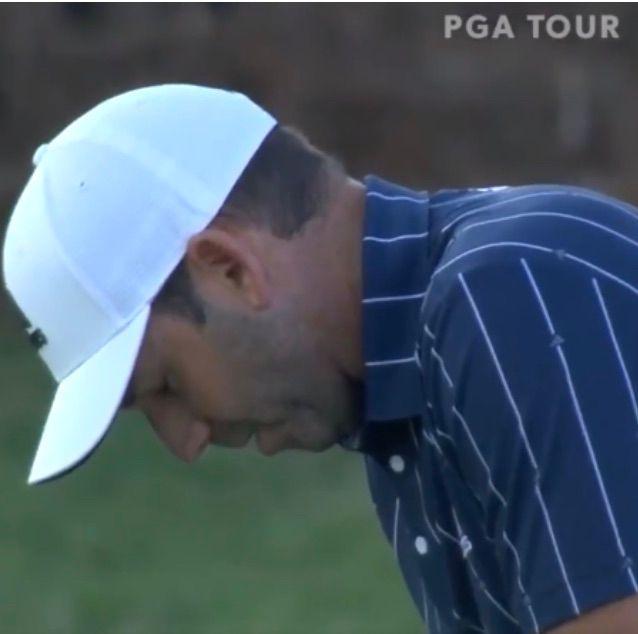
This is a scored drill where you will give yourself points based on performance. Choose a location on the putting green around 10’ from a hole and drop three balls, ensuring you don’t have the same putt each time. Follow your routine to read the putt and set up to the ball. Just before starting your backswing, close your eyes and then putt. After impact, call out the predicted result with your eyes still closed: “short/long left/right” or “in the hole.” When you open your eyes and see where the ball has come to rest, grade yourself on how close you were to the putt you felt.
E.g., If you missed long-left and you called it:
- Long-left = 2 points
- Short-left, Long-right = 1 point
- Short right = zero points
If you call the putt in the hole and make it, go ahead and give yourself three points. Follow the same process for the next two putts and note down your total score. Do the drill again to beat the score or track the average score over time to measure improvement.
Phil Mickelson’s Clock Drill
Catch a shot on TV of Phil warming up on the practice green; you will likely see him performing this classic clock drill. Place 10-12 balls in a three-foot circle around the hole or roughly one putter length.
The goal of the drill is simple, make the putts. As Phil says it, completing the drill gives him the confidence that if he can chip or lag to that distance, then he’ll make the putt. According to stats from Mark Broadie’s book Every Shot Counts, an 18 handicap golfer is missing three footers 16% of the time to use this confidence.
Set an initial goal of completing the circle and start over from the beginning if you miss it. As you continue to practice the drill, challenge yourself to keep increasing the number of putts made without a miss. If you manage to hit Phil’s goal of 100 putts in a row, be sure to let us know over in the Practical Golf forum.
Putting Games to Add Fun to Your Practice
The putting green at your course doesn’t have to be for serious practice, but can also be a great place to play a few games with your golf buddies using the skills acquired in these drills. Whether it’s just a friendly game or for sudden death to settle a tie out on the course, these games can add a bit of competition to your time on the green.
Par18
This game can be played either by just putting or chipping (as described in this article). The rules are simple; choose a starting point and a target practice hole and play it as a Par 2.
For a competitive game, you can play stroke play, match play, or even a Stableford scoring:
- Birdie (one putt): 2 points
- Par (two putts): 0 points
- Bogey (three putts): -1 point
- Double Bogey or more (more than three): -3 points
Alternate choosing the starting position between the different players and add up your scores to determine a winner.
Bocce Ball
This game is played just like the popular picnic pastime of bocce ball, only with putters out on the practice green. Played either 1-on-1 or in paired teams, you’ll need 3-4 golf balls per team (make sure they’re marked or otherwise recognizable to prevent arguments) and a colorful ball to act as the marker.
- Flip a coin to determine which player or team will putt the colored marker ball anywhere on the green. Marker putts that leave the green are fouls, and the other team gets to set the marker.
- Alternate putts between players to try to finish closest to the marker. Balls are not moved between putts, so striking other balls out of the way is allowed (and a lot of fun). The marker ball can also be knocked into different positions as long as it stays on the green. If the marker ball is knocked out of play, it is replaced at the original spot, and the ball that hit it is removed.
- Once all putts have been hit, the team with the closest ball to the marker gets one point for that ball and one additional point for each ball closer than the nearest opponent ball to the marker.
- Play to either a set number of rounds or to a predetermined total score.
One important side note: as this game can take up many the putting green surface, please be respectful of other golfers trying to practice.
More on Putting from Practical Golf:
6 TIPS FOR SUCCESS ON THE PUTTING GREEN
Also, you can check out my chipping drills article here or swing path drill guide.
We care about the protection of your data Read our Privacy Policy